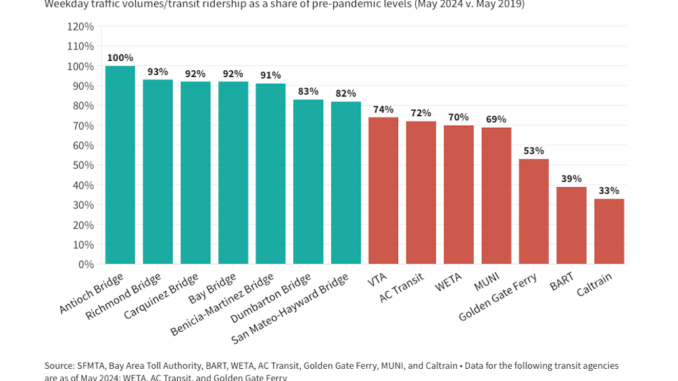
BY ELAINE GOODMAN
Daily Post Correspondent
Bay Area planners are overhauling a long-range transportation plan for the region to reflect changes in travel patterns following the Covid-19 pandemic.
Previously proposed transit projects are now being re-evaluated as transit ridership lags behind pre-pandemic levels, according to the two agencies developing the plan.
“These investments … now face a significantly reduced projected revenue stream,” the Association of Bay Area Governments (ABAG) and the Metropolitan Transportation Commission (MTC) said in a statement last week.
More specifics of the transportation plan will come out when the agencies release key documents this month. One of the documents, for example, will analyze costs and benefits of major transit projects that are being considered.
The transportation plan, known as Transit 2050+, will be rolled into a broader plan called Plan Bay Area 2050+. The plus signs in the plans’ names indicate they’re updates to earlier 2050 plans.
The plan will cover topics including housing, the economy and the environment, in addition to transportation.
“Rapid changes in commute patterns brought about by the Covid-19 pandemic, as well as significant reductions in anticipated transit revenues through 2050, demand a comprehensive overhaul of the six transit-related strategies included in Plan Bay Area 2050,” the agencies said.
A recent analysis by the Bay Area Council Economic Institute, a regional think tank, compared recovery of seven of the region’s transit agencies.
The Valley Transportation Authority, or VTA, which runs buses and light rail service, had the strongest recovery, with ridership in May 2024 at 74% of levels seen in May 2019. At the low end was Caltrain, with May 2024 ridership at only 33% of that in May 2019.
In contrast, traffic volumes across seven of the Bay Area’s toll bridges this May were close to volumes seen in May 2019. Dumbarton Bridge traffic volumes were at 83% of May 2019 levels; while traffic across the Antioch Bridge reached 100% of pre-pandemic volumes.
“People are potentially not using transit as much for work, but what can we do to enable them to use transit for other types of trips?” said MTC planner Kara Vuicich.
Committee Chairman James Spering noted that some post-pandemic changes, such as work-from-home trends may be permanent.
And in terms of funding transit projects, Spering said residents are getting tired of tax increases.
“If things don’t change, I don’t see that ridership coming back,” said Spering, a former Solano County supervisor.
Adina Levin with Seamless Bay Area, a transit advocacy group, said one reason transit hasn’t fully bounced back to pre-pandemic levels is because of Bay Area transit agencies’ focus on peak-commuting periods.
“In regions where they had better service before the pandemic, serving more kinds of riders, more kinds of trips, all day and all week, they’ve been more resilient and ridership has come back all the way or nearly all the way,” Levin told the committee.

I do not recommend public transit for my employees due to increased levels of crime, especially for female employees. Plus the added situation with illegals who may not abide by local laws, customs, and decorum. This is just the reality. Sorry to have to write about it, but voters should know the truth.
I wouldn’t be surprised if the Caltrain numbers are padded. I can’t believe how empty and wide open the trains are.
The population estimates used by Plan Bay Area 2050+ are wildly high compared to the CA Dept. of Finance. For 2060 (not 2050), the state agency charged with preparing estimates and projections forecasts an increase of only 700,000 people (not households).
Forecasts are inherently uncertain. For the regional agency to use wildly high numbers compared to the state’s estimates without addressing why undercuts their credibility as a neutral observer and planner for the Bay Area.